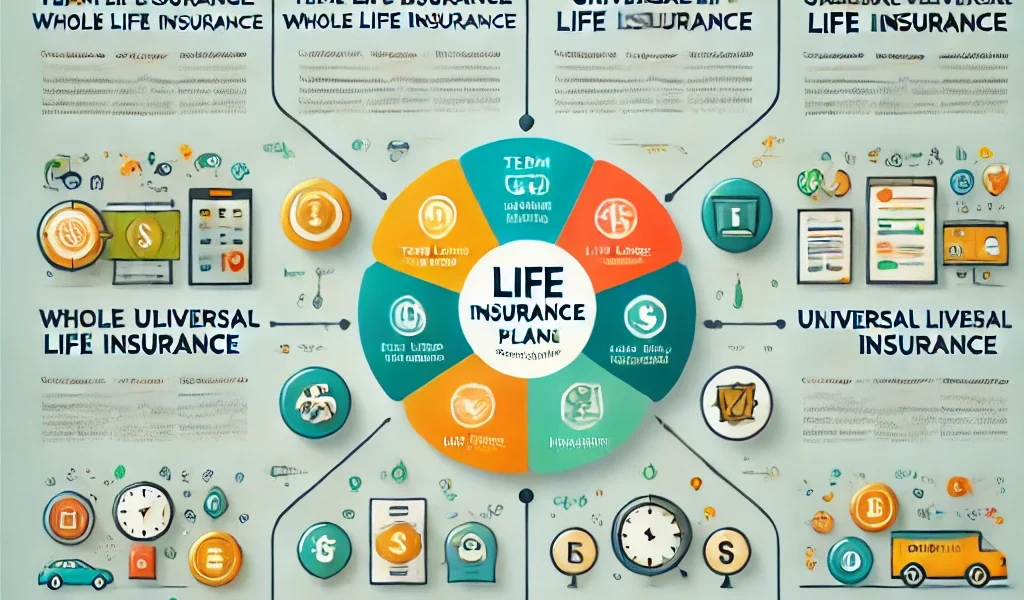When it comes to securing your family’s future, few financial tools are as important as life insurance. But with a variety of plans available, how do you know which one is the best fit for you? Whether you’re looking to protect your loved ones or invest for the future, understanding the nuances of life insurance can help you make an informed decision.
In this comprehensive side-by-side comparison, we break down the most popular life insurance plans, their key benefits, and potential drawbacks to help you determine which one suits your needs the most.
1. Term Life Insurance: The Simplicity of Protection
What It Is: Term life insurance provides coverage for a specified term, typically ranging from 10 to 30 years. If the policyholder passes away within this term, their beneficiaries receive the death benefit. However, if the term expires and the insured is still alive, the coverage ends with no payout.
Ideal For:
- Individuals who need affordable coverage for a set period (e.g., while raising children or paying off a mortgage).
- Those who only want life insurance for its death benefit without needing an investment component.
Pros:
- Affordable premiums compared to other types.
- Simplicity in structure.
- Provides substantial coverage.
Cons:
- No payout if the policyholder outlives the term.
- Does not accumulate cash value.
2. Whole Life Insurance: Lifetime Coverage with Investment
What It Is: Whole life insurance offers lifelong coverage, as long as premiums are paid. It also includes a savings component, known as the “cash value,” which grows at a guaranteed rate. This type of policy is often more expensive than term life but provides more than just a death benefit.
Ideal For:
- Those seeking long-term coverage and a forced savings plan.
- Individuals who want both death benefits and the ability to build cash value.
Pros:
- Lifetime coverage.
- Cash value accumulation that can be borrowed against.
- Predictable premiums.
Cons:
- Higher premiums than term life insurance.
- Cash value grows slowly in the early years.
3. Universal Life Insurance: Flexible and Adjustable
What It Is: Universal life insurance offers lifelong coverage and features a flexible premium structure. It combines a death benefit with a cash value account that earns interest. This plan allows policyholders to adjust their coverage and premium payments as their financial situation changes.
Ideal For:
- Individuals who want flexible premium payments and death benefit amounts.
- Those seeking the potential to accumulate cash value but with more control.
Pros:
- Flexibility in premium payments and death benefit.
- Potential for cash value accumulation.
Cons:
- Complexity in structure.
- Premiums can become higher if cash value decreases or if the insured’s financial situation changes.
4. Variable Life Insurance: Investment-Linked Coverage
What It Is: Variable life insurance is a permanent policy that includes both a death benefit and an investment component. Policyholders can invest the cash value in a variety of subaccounts, such as stocks and bonds, which can offer higher returns but also come with greater risks.
Ideal For:
- Individuals who want to combine life insurance with an investment strategy.
- Those with a higher risk tolerance who seek potential for higher returns.
Pros:
- Potential for high returns through investments.
- Flexibility in investment choices and death benefits.
Cons:
- Investment risks can result in lower cash value or even loss of the death benefit.
- Premiums can be high.
5. Final Expense Insurance: Affordable Coverage for Funeral Costs
What It Is: Final expense insurance is a type of whole life insurance that is designed to cover funeral expenses, medical bills, and other final costs. It typically offers a smaller death benefit and is easier to qualify for, making it an excellent option for older individuals.
Ideal For:
- Seniors looking to cover burial costs and final expenses.
- Those who don’t want their family to bear the financial burden of end-of-life costs.
Pros:
- Affordable premiums.
- Easier to qualify for, even for older individuals.
Cons:
- Smaller death benefit.
- Limited investment or cash value options.
How to Choose the Right Plan for You?
Choosing the right life insurance plan depends on several personal factors such as your age, financial goals, and risk tolerance. Here’s a quick guide to help you narrow down your options:
- For basic protection with low premiums: Consider Term Life Insurance.
- For long-term coverage and guaranteed cash value: Choose Whole Life Insurance.
- For flexibility and potential for investment growth: Go for Universal Life Insurance.
- For those with high-risk tolerance and investment goals: Opt for Variable Life Insurance.
- For seniors seeking affordable funeral expense coverage: Look into Final Expense Insurance.
Conclusion
Your life insurance needs are unique to your situation, and there is no one-size-fits-all solution. Whether you prioritize affordable premiums, investment opportunities, or lifetime coverage, understanding the differences between life insurance policies can empower you to make the best decision for your future.
SEO Tips for Readers:
- Always compare different life insurance options before committing.
- Consider how your personal situation (age, dependents, financial goals) impacts your choice.
- Work with an expert or financial advisor to find the best policy suited to your needs.
This blog covers all essential aspects of life insurance plans while engaging the reader with practical advice and clear comparisons. It’s optimized for search engines with keywords like “best life insurance plan,” “term life insurance,” “whole life insurance,” and more to attract relevant traffic.




